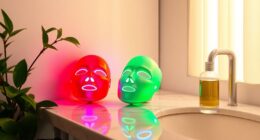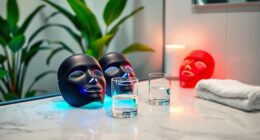LED lighting does generate heat, mainly because of semiconductor inefficiencies. LEDs are more energy efficient than traditional incandescent bulbs, which means they produce less heat. Although semiconductors in LEDs do create some heat, it is significantly lower than incandescent lighting. It is crucial to have proper thermal management for the longevity and performance of LEDs. Knowing how LED heat generation functions can assist users in maximizing lighting setups and ensuring efficiency.
Key Takeaways
- LEDs generate minimal heat due to their high energy efficiency.
- LED bulbs remain cool to touch even after prolonged use.
- Heat generation in LEDs is lower compared to incandescent bulbs.
- Efficient thermal management is crucial for LED longevity.
- Proper heat dissipation is essential for maintaining LED performance.
Understanding LED Heat Generation
LEDs generate heat primarily due to the inefficiency of semiconductors, converting a significant portion of input power into heat rather than visible light. When electricity flows through an LED bulb, only a fraction is transformed into the desired light output, while the rest is dissipated as heat. In fact, the wall-plug efficiency of LED packages can range from 5% to 40%, with a typical LED emitting around 85% heat and only 15% visible light. This heat generation poses challenges for maintaining peak performance and longevity in LED bulbs.
Understanding the balance between light emission and heat dissipation is essential for enhancing the efficiency and lifespan of LEDs. Elevated junction temperatures resulting from excessive heat can accelerate LED deterioration, impacting important characteristics such as forward voltage and lumen output. Hence, efficient thermal management is vital to mitigate these effects and ensure that high-power LEDs operate at their best performance levels. Proper heat sinking design and accurate junction temperature calculations are fundamental strategies in maximizing the effectiveness of LED lighting systems.
Factors Affecting LED Temperature

LED temperature is influenced by factors like drive current, ambient temperature, and LED wattage per unit area. Junction temperature plays an important role in determining LED characteristics such as forward voltage and lumen output.
Efficient thermal management techniques are essential to guarantee LED performance and prevent damage from elevated junction temperatures.
LED Heat Dissipation
Efficient heat dissipation plays a critical role in maintaining the best performance and longevity of light-emitting diodes (LEDs). To guarantee ideal LED temperature management, factors such as junction temperature, thermal conductivity of materials, and wall-plug efficiency must be considered.
Key points to note about LED heat dissipation include:
- Heat sinking is essential for preventing changes in LED characteristics.
- Elevated temperatures can lead to rapid LED deterioration.
- Materials with high thermal conductivity enhance heat transport efficiency in LEDs.
- LED packages often lose a significant portion of input power as heat, necessitating proper thermal management for energy efficiency and extended lifespan.
Thermal Management Techniques
Implementing effective thermal management techniques is essential for maintaining peak performance and longevity of light-emitting diodes (LEDs). LED bulbs produce heat during operation, impacting their light output and overall efficiency.
Factors such as ambient temperature, drive current, and LED wattage per unit area can influence the junction temperature of LEDs. Efficient thermal management is vital, especially for high-power LEDs, to prevent changes in LED characteristics like forward voltage and lumen output.
Sealed fixtures can hinder proper thermal transfer, potentially affecting LED performance. Understanding fixture performance is key to estimating LED lifetime under various operating conditions.
Comparing LED Vs. Incandescent Heat

When comparing LED lighting to incandescent bulbs regarding heat production, the contrast is remarkable. LED bulbs are much more energy-efficient, which translates to much less heat being generated compared to incandescent bulbs.
Here are some key points to ponder:
- LED lights produce minimal heat due to their energy efficiency.
- In contrast, incandescent bulbs waste up to 90% of electricity as heat.
- LED bulbs can be touched even after prolonged use, showcasing their cool operation.
- The absence of a heated filament in LED lights reduces the risk of fire hazards.
These factors highlight the clear advantage of LED lights over incandescent bulbs when it comes to heat production. LED lights not only help in reducing energy consumption but also contribute to a cooler and safer lighting environment.
Impact of Heat on LED Lifespan
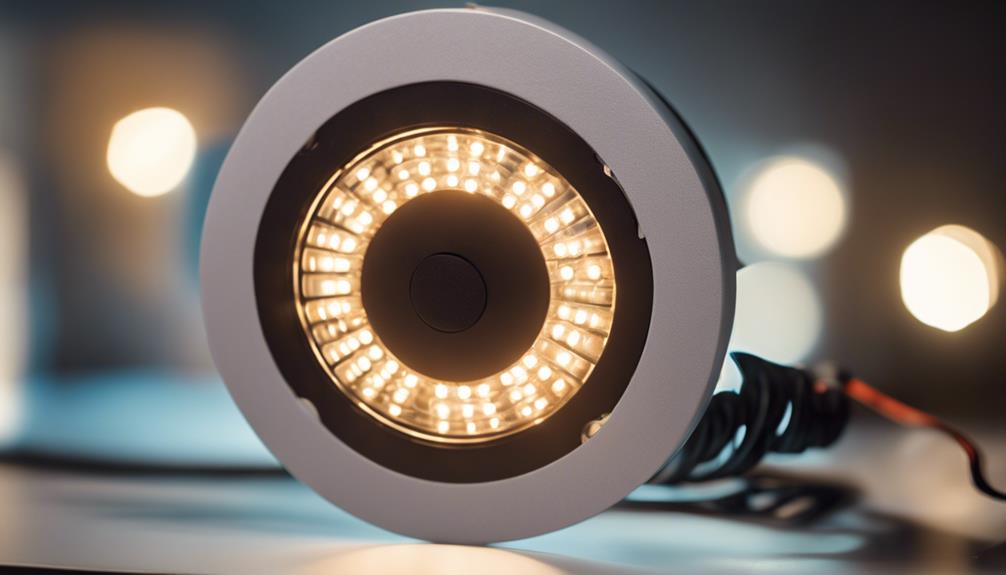
Elevated junction temperatures can greatly impact the lifespan of LED lights over time. When LEDs are driven above their rated peak current, the resulting increase in junction temperature can lead to accelerated deterioration and permanent damage.
Factors such as ambient temperature, drive current, and LED wattage per unit area all contribute to the junction temperature of LEDs. Efficient thermal management is vital, especially for high-power LEDs, to mitigate changes in LED characteristics caused by excessive heat.
Calculating the junction temperature not only helps estimate the LED's lifetime within fixtures but also provides valuable insights into LED longevity under varying operating conditions. By understanding the impact of heat on LED lifespan and implementing appropriate thermal management strategies, users can optimize the performance and durability of LED lighting systems.
Prioritizing proper heat dissipation is essential for ensuring the longevity and efficiency of LEDs in various applications.
Tips for Proper LED Ventilation
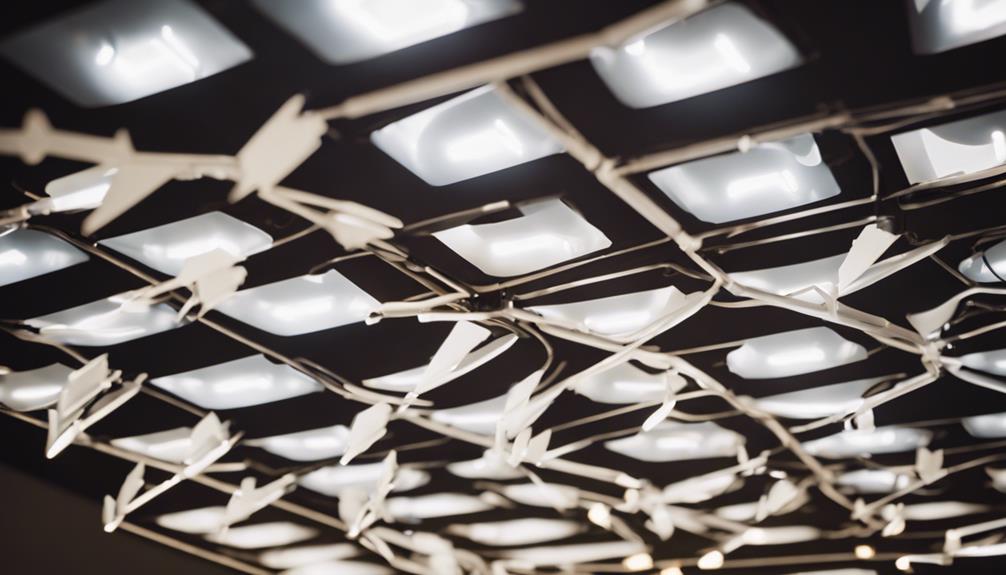
Proper ventilation plays a critical role in maintaining the best performance and longevity of LED lights. LED bulbs generate minimal heat, and adequate airflow is essential for effective heat dissipation. To guarantee ideal ventilation for LED fixtures, consider the following tips:
- Avoid Enclosures: LED fixtures shouldn't be enclosed in tight spaces to allow heat to dissipate efficiently.
- Unblock Airflow: Make sure that there are no obstructions blocking the airflow around LED bulbs to facilitate heat dissipation.
- Well-Ventilated Spaces: Providing well-ventilated areas around LED lights helps in maintaining a cooler operating temperature.
- Prevent Overheating: Good ventilation practices can prevent overheating issues, contributing to extending the lifespan of LED lighting systems.
Advancements in LED Heat Efficiency

Advancements in LED technology have revolutionized heat efficiency in modern lighting systems. With advanced design features and improved thermal management techniques, LED lights now produce much less heat compared to traditional lighting sources. The efficient heat dissipation mechanisms in modern LED bulbs play an essential role in maintaining low operating temperatures, ensuring not only the comfort and safety of users but also enhancing the longevity and reliability of the lighting fixtures.
These developments in LED technology have also led to increased energy efficiency in lighting systems. By reducing heat production and implementing better thermal management, LED fixtures can operate with minimal energy wastage, making them a sustainable and eco-friendly lighting solution. Ongoing research continues to focus on optimizing heat efficiency in LED lighting, aiming to further enhance energy savings and environmental benefits. Overall, these advancements demonstrate the continuous commitment to improving the performance and sustainability of LED lighting systems.
Managing Heat in Commercial LED Lighting

Effective heat management is essential for ensuring peak performance in commercial LED lighting systems. To manage heat effectively in commercial LED lighting, several key strategies can be employed:
- Efficient Heat Sinking: Proper heat sinking mechanisms are critical to dissipate heat effectively and prevent overheating in LED fixtures.
- Thermal Management: Implementing efficient thermal management techniques helps maintain the temperature within safe operating limits for LEDs.
- Calculating Thermal Resistance: By calculating thermal resistance, it becomes easier to assess how well heat is being dissipated within the LED lighting system.
- Monitoring Junction Temperatures: Keeping a close eye on junction temperatures is important, as elevated temperatures can lead to rapid LED deterioration, impacting the overall performance and longevity of the lighting system.
Common Myths About LED Heat
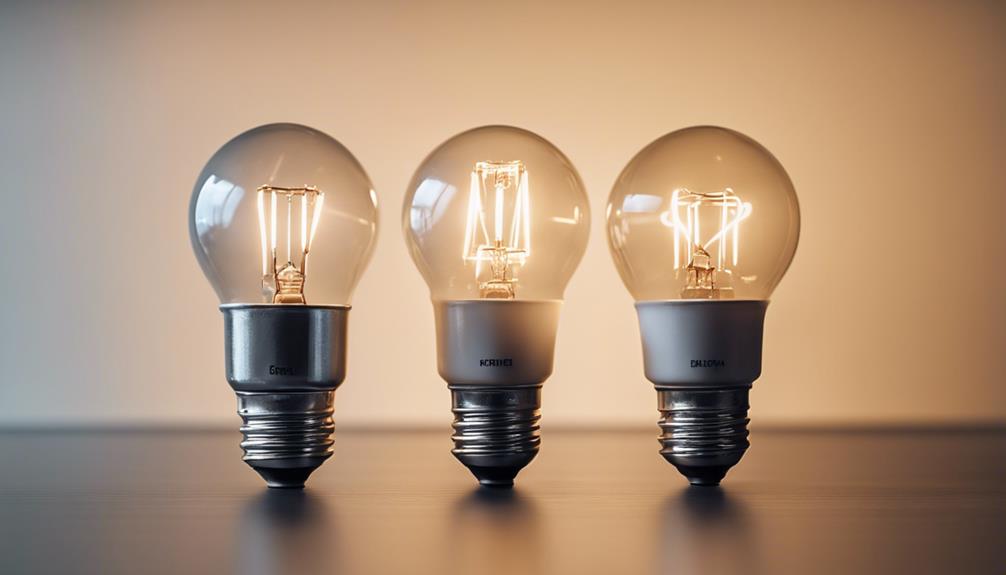
LED lighting's minimal heat production has led to several common myths about its heat emission. One prevalent misconception is that LEDs don't produce any heat at all, which is untrue. While LEDs are more efficient than incandescent bulbs in converting electricity into light rather than heat, they still generate some heat due to semiconductor inefficiency. Another myth is that all the energy consumed by an LED is turned into light, neglecting the fact that LED packages typically have a wall-plug efficiency ranging from 5% to 40%. Efficient thermal management is vital for LEDs to maintain their performance and longevity. Elevated junction temperatures can accelerate LED deterioration, emphasizing the importance of managing heat effectively. To debunk these myths and understand the significance of proper thermal management in LED lighting, it is crucial to recognize the balance between heat generation and dissipation in semiconductor devices.
| Myth | Fact |
|---|---|
| LEDs don't produce heat. | LEDs generate heat due to semiconductor inefficiency. |
| All energy consumed by LEDs is converted into light. | LED packages have a wall-plug efficiency of 5-40%. |
| LEDs don't require thermal management. | Efficient thermal management is essential to prevent changes in LED characteristics. |
| High heat levels have no impact on LED performance. | Elevated junction temperatures can lead to rapid LED deterioration. |
| LED heat is not a significant factor necessary to take into account in lighting applications. | Proper thermal management is vital to maintain LED performance and longevity. |
Frequently Asked Questions
Is It Normal for LED Lights to Get Hot?
LED lights typically remain cool during operation due to their energy-efficient design. The minimal heat produced by LEDs is markedly lower than that of traditional incandescent bulbs. Their efficient heat dissipation mechanisms guarantee they don't get hot to the touch.
LED bulbs are safe for use in various settings, as they don't pose fire hazards or burn risks. This design feature enhances their longevity and performance by managing heat effectively.
Do LED Lights Heat up a Room?
LED lights don't heat up a room noticeably due to their energy efficiency. The minimal heat generated by LEDs doesn't contribute to a rise in room temperature.
These lights are cool to the touch and don't emit infrared radiation that warms up surroundings.
Unlike traditional bulbs, LEDs don't produce excessive heat, making them ideal for maintaining room temperature and reducing the need for additional cooling systems.
What Kind of Light Bulbs Don't Get Hot?
LED light bulbs are known for their ability to emit minimal heat compared to traditional incandescent bulbs. This is due to their energy-efficient design and semiconductor technology, which helps them remain cool to the touch.
LED lighting produces more light and less heat, making them a safe option. By choosing LED bulbs, individuals can reduce the risk of burns or fire hazards associated with hot traditional bulbs.
How to Reduce Heat From LED Lights?
To reduce heat from LED lights, ensuring proper ventilation and fixture design is essential. Heat dissipation is managed through efficient thermal management and heat sinks.
LEDs' cool operation is due to minimal heat production and lack of infrared radiation emission. Effective thermal management is vital for maintaining LED performance and longevity.
Conclusion
In summary, LED lighting does generate some heat, but it's considerably lower compared to traditional incandescent lighting. Proper ventilation and heat management are essential for ensuring the longevity and efficiency of LED fixtures.
By understanding the factors affecting LED temperature, users can maximize the benefits of this energy-efficient lighting option. Remember, a cool LED is a happy LED, so keep those lights shining bright with proper care and maintenance.



